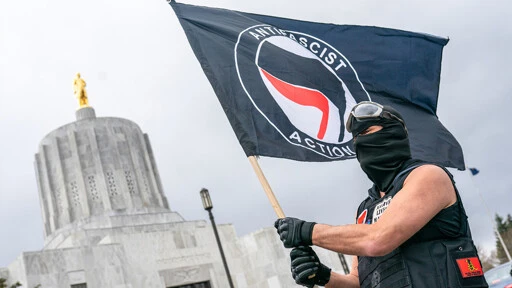Antifa as a scapegoat for American decay
Antifa as a scapegoat for American decay

Antifa como chivo expiatorio de la descomposición estadounidense

By: Carmen Parejo Rendón
Published: Sep 26, 2025 3:56 PM GMT
First they came for the communists, and I didn't speak out because I wasn't a communist. Then they came for the trade unionists, and I didn't speak out because I wasn't a trade unionist. Then they came for the Jews, and I didn't speak out because I wasn't Jewish. Then they came for me, and there was no one left to speak out.
With this poem, the German pastor Martin Niemöller synthesized the gradual process of persecution that unfolds in moments of heightened capitalist crisis: the degenerative form that the system takes when its legitimacy falters.
First, he criminalizes the most vulnerable, then organized crime , and finally, anyone who dares to question him. This logic of progressive fascistization marks Donald Trump's second term today. First, it was migrants, then the homeless, then critical students , and now, with the recent declaration of "Antifa" as a terrorist organization, the door is open to an open offensive against all dissent.
In September 2025, Trump signed an executive order formally designating Antifa as a domestic terrorist organization. The order states that they are " a militaristic and anarchist enterprise that explicitly calls for the overthrow of the United States government" and that they coordinate "violent attacks" and "obstruction of federal law" through harassment, doxxing, and aggressive demonstrations.
The White House instructs federal agencies to "investigate, dismantle, and disrupt" any associated operations. But this decree does not come in a vacuum: it adds to policies already in place, such as tightening immigration laws, expedited deportations, and refugee status reviews. It is, in short, part of a strategy of institutionalized and escalating repression .
The decision is based on a false but politically useful premise: that Antifa is a structured organization, with hierarchies and its own operational capacity. In reality, it is not a centralized party or collective, but rather a loose label that encompasses multiple expressions of antifascism—decentralized, local, often spontaneous, and without recognized spokespersons.
Declaring Antifa a terrorist is equivalent to declaring an adjective a terrorist . This ambiguity makes it dangerous, as it allows the state to persecute not concrete facts, but ideological positions. In the hands of the state, Antifa becomes an empty category that can be filled at will: today a hooded protester, tomorrow a critical professor, an inconvenient journalist, or any citizen who challenges the established order.
The criminalization of Antifa marks a turning point in the American repressive architecture because it no longer targets facts, but rather political affinities. Under this doctrine, any citizen who organizes, protests, or simply dissents can be labeled a "domestic terrorist." The terrain of dissent becomes a minefield.
The decree not only threatens traditionally mobilized sectors—civil rights organizations, environmentalists, racial justice movements—but also moderate opponents: from the Democratic Party to critical currents within the Republican Party itself, including even factions within the MAGA universe that question Trump for not being radical enough. Anyone can be Antifa. The label functions as an empty signifier that includes anyone who inconveniences those in power, whether they come from the left or even the far right.
This is not a new resource. During Barack Obama's administration, the specter of "radical groups" was already exploited to dismantle Occupy Wall Street. That movement was discredited, infiltrated, and dismantled with covert violence, through a coordinated offensive involving federal agencies, local police, and the judiciary. Diffuse categories like "anarchist," "radical," or "antifa" then served to justify repression beyond the scope of public order . Obama, thus, was also a link in the chain of ideological and social control that Trump today takes to its most grotesque expression.
This authoritarian turn does not respond to Trump's personal whim, but to a structural logic. Internal repression is a reflection of a rotting system. American capitalism is undergoing a crisis of legitimacy, accumulation, and global hegemony. Financialization, industrial depletion, the collapse of public services, and chronic indebtedness have deteriorated both the quality of life of millions and the social cohesion that sustained the myth of the "American Dream." Internationally, the emergence of powers like China, the restructuring of the Global South, and the loss of influence in strategic arenas—from the Indo-Pacific to Latin America—reveal imperial decline. In this context, the discourse of the "internal enemy" and the promise of order function as tools of containment in the face of an inevitable social upheaval.
This pattern did not begin with Trump, although he has accelerated it. Trump is not the cause of America's ills, but rather an increasingly visible consequence of its decline. The country that proclaims itself the "cradle of freedom" has escalated, crisis after crisis, in authoritarianism: from McCarthyism in the 1950s to the Patriot Act after 9/11, with the legalization of mass surveillance and a permanent state of emergency . Today, with the use of "Antifa" as a repressive category, this decline continues.
The deterioration is progressive, and each crisis accelerates it. If it's not stopped, if its full structural dimension isn't understood, there will come a time when, as Niemöller warned, there will be no one left to say anything when they come for you too .